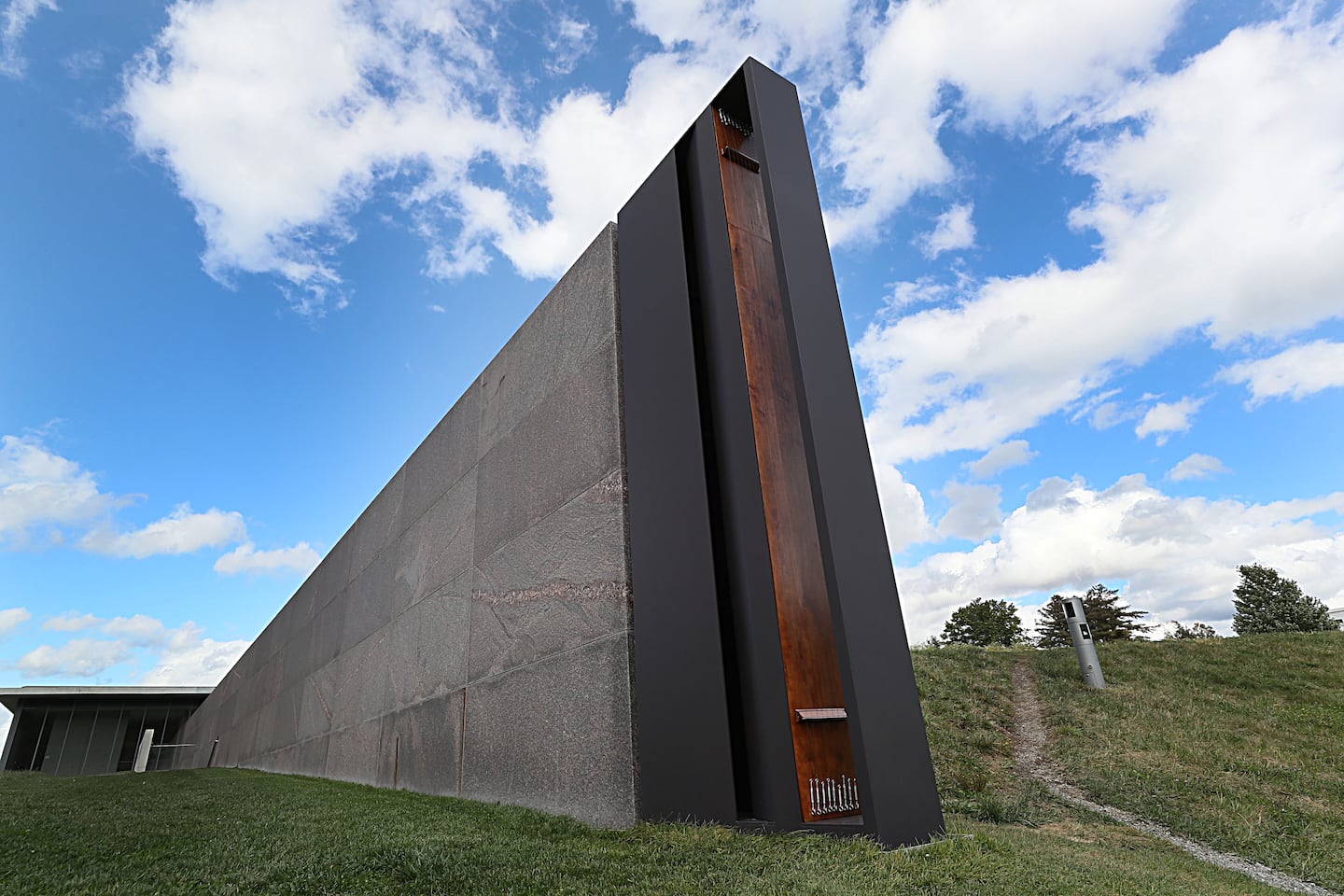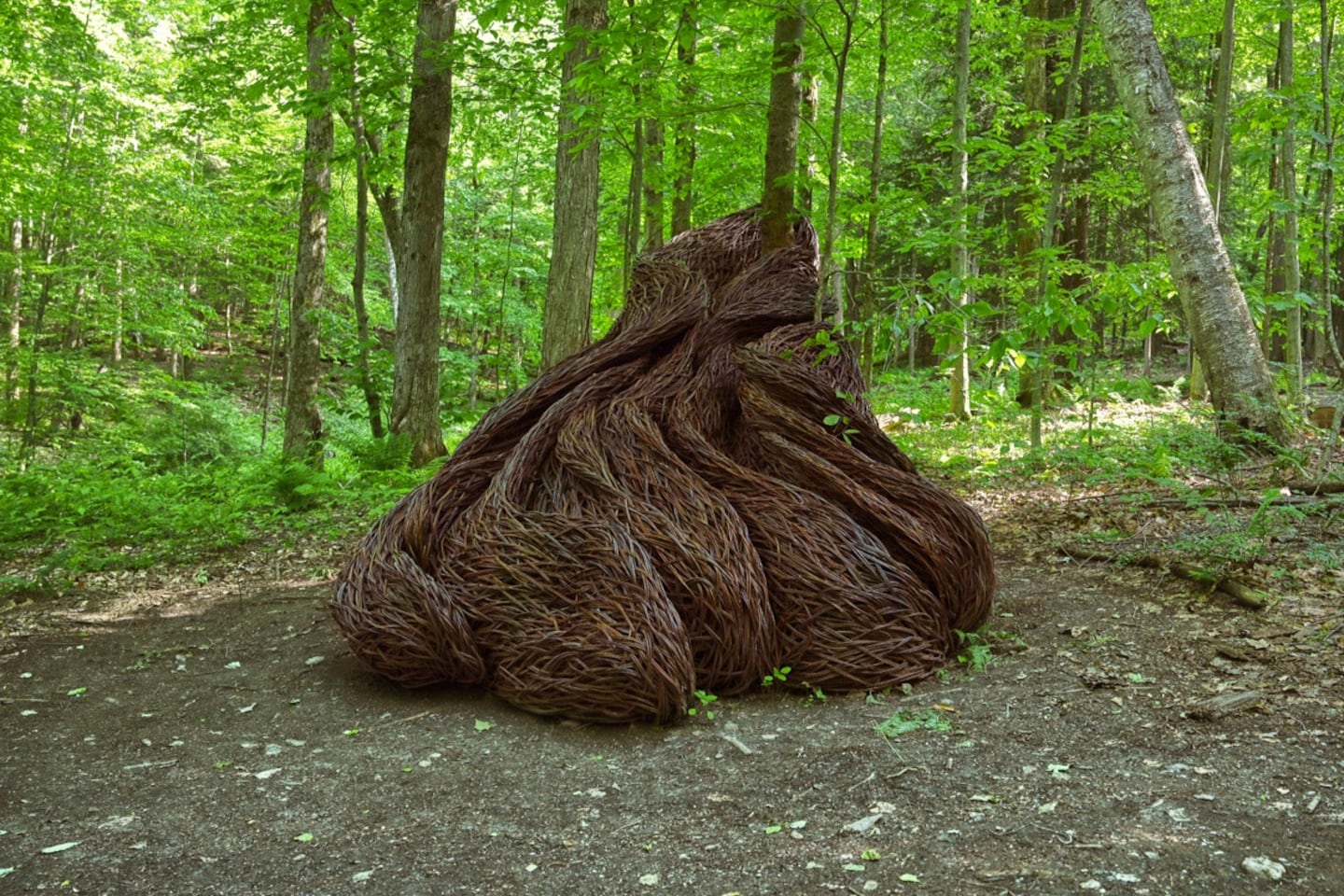 Hugh Hayden’s “the End,” 2025, in the forest above the Clark Art Institute for the museum’s outdoor sculpture exhibition “Ground/work,” open through October 2026.Hugh Hayden, Courtesy Lisson Gallery
Hugh Hayden’s “the End,” 2025, in the forest above the Clark Art Institute for the museum’s outdoor sculpture exhibition “Ground/work,” open through October 2026.Hugh Hayden, Courtesy Lisson Gallery
The piece’s prompt to the imagination is where its power lies (a metaphor for climate catastrophe, nature under threat, is my read, but you do you; that’s the point). Hayden’s virtuosic exhibition at the Rose Art Museum earlier this year helps provide deeper insight into his own intent.
Hayden, who is Black, explores the divisions of race and class in his work in novel ways most often expressed through his astonishing fluency in woodworking. “Unless you’re an orthopedist or an archeologist,” Hayden is quoted as saying on a little trailside sign near his felled giant, “you cannot tell if someone is Black or white, male or female, just by looking at their bones.” In what might be the most powerful expression of the equality Hayden seeks, the piece, the product of untold hundreds of hours of labor, will be left on the soft forest floor long after “Ground/work” closes next October, there to rot and be swallowed by the earth. Ashes to ashes, dust to dust. It comes for us all.
If you hadn’t guessed, “the End” was for me the most provocative of the “Ground/work” set, an inevitably uneven grouping of outdoor-friendly sculptural works with no more in common than the massive sprawl of acreage they share (bring water; wear sturdy shoes). Even so, the walk is worth it, particularly if you like your autumnal leaf-peeping to be more than merely bucolic (though on the Clark grounds, rising above the little valley that cradles Williamstown in an embrace of greenery, there’s plenty of that. Wow.).
 “These (Mournful) Shores” by Jennie C. Jones at the Clark Art Institute’s inaugural “Ground/work” show in 2020.Suzanne Kreiter/Globe staff
“These (Mournful) Shores” by Jennie C. Jones at the Clark Art Institute’s inaugural “Ground/work” show in 2020.Suzanne Kreiter/Globe staff
This is round two of a Clark initiative begun in 2020. “Ground/work” 1.0 ended up being an unintentional pandemic salve, out in the open air when buildings like museums were either locked up tight or severely restricting numbers. That year, just the opportunity to see and do something, anything, powered the display as much as any of the works; they weren’t made to respond to the moment, planned more than a year prior.
Still, like Hayden’s, they allowed for ample projection: I can still conjure up “These Mournful Shores,” Jennie C. Jones’s towering rectilinear harp affixed to the Clark’s looming granite feature wall. When the breeze hit the taut strings inside, the mournful whisper it produced was uncanny, a ghostly lament suited to any number of past sufferings or scourge.
 Aboubakar Fofana’s sculptural pieces at the Clark Art Institute’s “Ground/work.”The Clark Art Institute
Aboubakar Fofana’s sculptural pieces at the Clark Art Institute’s “Ground/work.”The Clark Art Institute
Granted, it was a moment, and one we never want to see again, but the 2025 version feels less like provocation and more like diversion. A pair of unassuming iron stems planted in the woods along the path, a piece by Aboubakar Fofana, feels oddly out of place here; circular protrusions curl in a uniform pattern up and down each one, all holding tightly wound spirals of yarn. Fofana’s devotion to West African textile dyeing — an ancient practice, and one he’s dedicated to preserving — is a worthy pursuit but could be anywhere. It feels like it got off at the wrong bus stop, now left waiting for a ride home.
 Laura Ellen Bacon, “Gathering My Thoughts,” 2025, at the Clark Art Institute’s “Ground/work.”The Clark Art Institute
Laura Ellen Bacon, “Gathering My Thoughts,” 2025, at the Clark Art Institute’s “Ground/work.”The Clark Art Institute
A little deeper in the woods, a menacing hulk of woven wood winds itself around a tree trunk. An amorphous tangle of dark branches, the soft curve of its bulk prompts notions of movie monsters — faceless, mindless, a blob made to swallow everything in its path. I loved it. But here, a little knowledge is too much. A masterwork of wattling — an age-old British technique of weaving tensile willow branches into tight networks of fencing, or baskets — it would be a brilliant perversion of technical practicality, if its purpose were a little less mundane. “Gathering My Thoughts” is its bland title, by the British artist Laura Ellen Bacon, but it feels more like an afterthought. Sigh. I don’t need anyone to read meaning for me, but at least leave room to make my own.
Over the hill and through the woods is a clearing, where Milena Nauf’s very large “Three Times Spanning,” a pair of giant odd-angled marble slabs rest by a felled tree. The prompt to midcentury abstraction (think of the various puzzling adornments to the sidewalks of financial district office towers all over the world) is both clear, and sly. Nauf, who is German, takes that prevailing empty formal gesture and loads it up with very personal content.
 Milena Naef, “Three Times Spanning,” 2025, at the Clark Art Institute’s “Ground/work.”Murray Whyte/Globe Staff
Milena Naef, “Three Times Spanning,” 2025, at the Clark Art Institute’s “Ground/work.”Murray Whyte/Globe Staff
She’s the latest in a long line of Swiss stone carvers. The marble is from the one and only quarry in Switzerland. Come close and you’ll see Nauf’s own body scored into the cold stone, the imprints of her hip, breast, chin, and ear in unmistakeable high-relief profile. Her shoulder breaks through the stone, making a fissure in its hide where the sun shines through — puncturing, among other things, the oblique and anodyne pretensions of pure form. I wouldn’t say I liked the piece, necessarily, but to respect and admire the thoroughness of intention, you don’t have to.
 Yō Akiyama, “Oscillation: Vertical Garden,” 2025, at the Clark Art Institute’s “Ground/work,” 2025.Murray Whyte/Globe Staff
Yō Akiyama, “Oscillation: Vertical Garden,” 2025, at the Clark Art Institute’s “Ground/work,” 2025.Murray Whyte/Globe Staff
Crest the ridge and land at “Oscillation: Vertical Garden” by the Japanese artist Yo Akiyama, a blackened cone, 15 feet tall, with the rough, ridged scales like a fossilized dinosaur hide. It catches your attention, I’ll give it that. A rough spiral of clay dusted with iron powder, its dull skin looks like something salvaged from flame. A prompt for the imagination surrounded by lush glades, it seemed ominous, a charred endgame for an overheated planet. Beautiful and threatening, it moved the mind.
 Javier Senosiain, “Coata III,” 2025.The Clark Art Institute
Javier Senosiain, “Coata III,” 2025.The Clark Art Institute
Back into the woods, it served as a good appetizer to Hayden’s work still to come. Leaving, you could amble down those Berkshire hills slightly troubled — as you should be — about the beauty of a world under increasing threat. But on the way out, spectacle over substance bids you farewell: “Coata III,” a bright mosaic-tile sea serpent by the Mexican architect Javier Senosiain, slithers in the museum’s pond next to the parking lot. It’s an allusion to Quetzalcoatl, an Aztec god of knowledge, art, and agriculture. Meaning what, here, and why, you might wonder? Me too.
GROUND/WORK
At the Clark Art Institute, 225 South St., Williamstown. Through Oct. 12, 2026. 413-458-2303, www.clarkart.edu
Murray Whyte can be reached at murray.whyte@globe.com. Follow him @TheMurrayWhyte.

